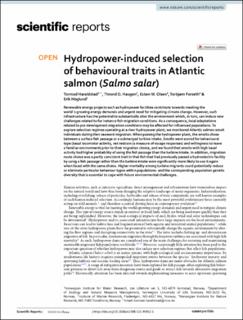| dc.contributor.author | Haraldstad, Tormod | |
| dc.contributor.author | Haugen, Thrond Oddvar | |
| dc.contributor.author | Olsen, Esben M. | |
| dc.contributor.author | Forseth, Torbjørn | |
| dc.contributor.author | Höglund, Erik | |
| dc.date.accessioned | 2021-12-10T12:47:39Z | |
| dc.date.available | 2021-12-10T12:47:39Z | |
| dc.date.created | 2021-12-09T19:53:35Z | |
| dc.date.issued | 2021 | |
| dc.identifier.citation | Scientific Reports. 2021, 11, 16444. | en_US |
| dc.identifier.issn | 2045-2322 | |
| dc.identifier.uri | https://hdl.handle.net/11250/2833811 | |
| dc.description.abstract | Renewable energy projects such as hydropower facilities contribute towards meeting the world`s growing energy demands and urgent need for mitigating climate change. However, such infrastructure has the potential to substantially alter the environment which, in turn, can induce new challenges related to for instance fish migration conditions. As a consequence, local adaptations related to pre-development migration conditions may be affected for influenced populations. To explore selection regimes operating at a river hydropower plant, we monitored Atlantic salmon smolt individuals during their seaward migration. When passing the hydropower plant, the smolts chose between a surface fish passage or a submerged turbine intake. Smolts were scored for behavioural type (basal locomotor activity, net restrain (a measure of escape responses) and willingness to leave a familiar environment) prior to their migration choice, and we found that smolts with high basal activity had higher probability of using the fish passage than the turbine intake. In addition, migration route choice was a partly consistent trait in that fish that had previously passed a hydroelectric facility by using a fish passage rather than the turbine intake were significantly more likely to use it again when faced with the same choice. Higher mortality among turbine migrants could potentially reduce or eliminate particular behaviour types within populations- and the corresponding population genetic diversity that is essential to cope with future environmental challenges. | en_US |
| dc.language.iso | eng | en_US |
| dc.publisher | Nature | en_US |
| dc.rights | Navngivelse 4.0 Internasjonal | * |
| dc.rights.uri | http://creativecommons.org/licenses/by/4.0/deed.no | * |
| dc.title | Hydropower-induced selection of behavioural traits in Atlantic salmon (Salmo salar) | en_US |
| dc.title.alternative | Hydropower-induced selection of behavioural traits in Atlantic salmon (<i>Salmo salar</i>) | en_US |
| dc.type | Peer reviewed | en_US |
| dc.type | Journal article | en_US |
| dc.description.version | publishedVersion | en_US |
| dc.rights.holder | © The Author(s) 2021 | en_US |
| dc.source.pagenumber | 9 | en_US |
| dc.source.volume | 11 | en_US |
| dc.source.journal | Scientific Reports | en_US |
| dc.identifier.doi | 10.1038/s41598-021-95952-1 | |
| dc.identifier.cristin | 1966831 | |
| dc.source.articlenumber | 16444 | en_US |
| cristin.ispublished | true | |
| cristin.fulltext | original | |
| cristin.qualitycode | 1 | |

